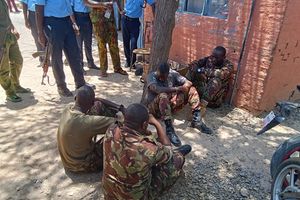Galana-Kulalu food security scheme that has yielded little

Maize farm at Galana Kulalu in Tana River County, which is part of the Galana Kulalu Food Security Project. PHOTO | FILE | NATION MEDIA GROUP
What you need to know:
- The number of those affected by hunger is expected to rise from 1.5 million last October to two million at the end of this month.
- The worst hunger affected parts of the country are just next to the irrigation scheme.
- Kilifi and Tana River, according to the national drought early warning bulletin, have been the hardest hit.
As millions of Kenyans grapple with food shortages, many are wondering what happened to the Jubilee flagship project of Galana-Kulalu food security scheme, touted as a solution to cyclic hunger problems in the country.
This was one of the key campaign promises that the Jubilee administration made in its manifesto to make Kenya a food-secure nation through the one-million-acre Galana-Kulalu irrigation project.
To date, only 5,000 acres out of the targeted one million have been put under crop, even as millions of Kenyans are going to bed without food as a result of the ravages of drought.
The government projects that the number of those affected by hunger is expected to rise from 1.5 million last October to two million at the end of this month.
CLIMATE CHANGES
The key mandate of the Galana irrigation project was to move the country from rain-fed agriculture in the wake of climate changes.
On completion, the project was supposed to bring on board over 20 million bags of maize, a move that would have boosted the available stocks from farmers and slashed imports from Uganda and Tanzania.
The National Irrigation Board (NIB), the implementer of the project, says 85 per cent of the infrastructural works have so far been completed in the first phase of the model farm, with 75 per cent of the Sh7 billion budget for the first phase having been spent so far.
Acting general manager Mugambi Gitonga said planting only constitutes a smaller fraction of the entire work and that the most important work was clearing of the bush and laying of infrastructure.
PLANTED MAIZE
“We have so far planted maize in 5,000 acres of land and 85 per cent of works on the farm, which is actually the key activity in this project, has been covered,” said Mr Gitonga.
Mr Gitonga said when the government initiated the million-acre project, the focus was not only on Galana but countrywide, pointing out that NIB has so far put 400,000 acres of land under irrigation across the country.
Asked for his opinion over the Galana project, the chairperson of Parliamentary Committee on Agriculture Mohamed Noor, said Galana was a good project, only if implementation was proper.
GOOD CONCEPT
“Galana itself is a good concept, but the implementation has not been done properly,” said Mr Noor in an interview.
The worst hunger affected parts of the country are just next to the irrigation scheme. Kilifi and Tana River, according to the national drought early warning bulletin, have been the hardest hit.
Mr James Nyoro, special adviser to the presidency, in a previous interview, said small-scale holders should abandon maize farming and instead plant other crops while the government should focus on rolling out mega irrigation projects.





